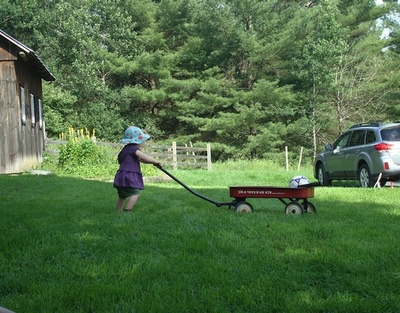This moment: Fall collection
/From Soulemama: A Friday ritual. A single photo - no words - capturing a moment from the week. A simple, special, extraordinary moment. A moment I want to pause, savor and remember.
From Soulemama: A Friday ritual. A single photo - no words - capturing a moment from the week. A simple, special, extraordinary moment. A moment I want to pause, savor and remember.
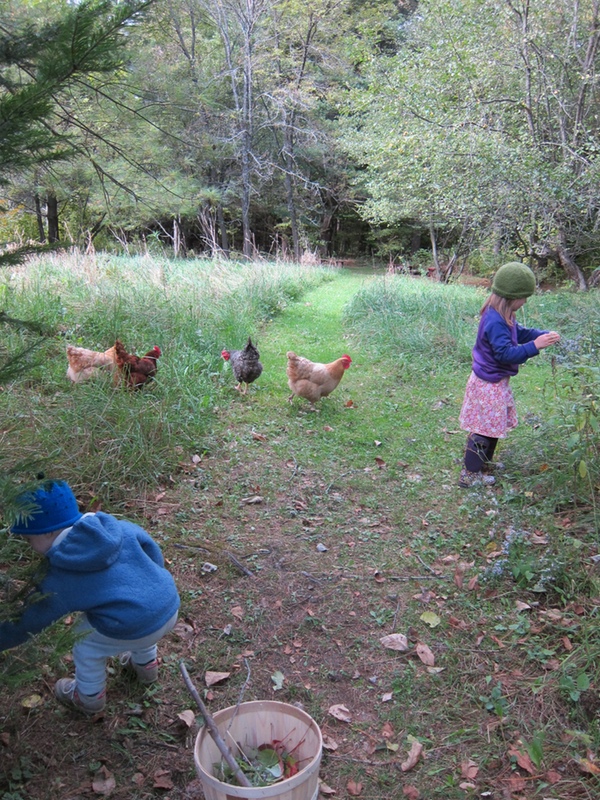
Screen time tends to be a sensitive topic that often leaves parents feeling defensive. Please note that I do not mention whether we do or do not allow screen time for our children, or if we do, what kind or how much. This post is not meant to address or judge any individual situation; rather, I am interested in exploring the topic of screen time at a more global level, and reflect on my own observations in hopes of articulating my concern about the impact of screen time on children.
----------------------------
Recently, my friend posted a link on Facebook to this article. It is a short piece in which Susan Linn argues that screen time deprives kids of the opportunity to be creative, which is detrimental to development. Here is an excerpt that captures the main point:
As with everything, there is a range of tolerance among parents when it comes to screen time. There are, of course, the two extremes – those who prohibit any screen time and those who allow a free-for-all, but most parents fall somewhere in the middle, acknowledging that screen time generally isn’t good for young children, but still allowing it in moderation due to the reality of our culture.
For example, it is pretty common for kids to watch TV here and there so the parents can take a shower in the morning, respond to an important work email, make a few quick phone calls, or prepare dinner late in the afternoon. The TV/Computer/iPhone is the perfect babysitter – it is available on demand, captivating, and free. In other words, it is a sure thing - parents can do what they need to do, knowing their kids are occupied and safe. On a day-to-day basis, it doesn’t seem like such a bad thing, to allow a little screen time in order to get things done, especially if parents are conscientious about what they allow their children to watch. Many TV shows are gentle, benign stories, and there are hundreds of educational apps that teach kids about music, nature, math, art, reading, etc. In other words, the content isn’t detrimental in any way. In fact, in the comments section of Linn’s article, some argue that screen time may even be beneficial, and that technology not only allows for creativity, but also allows for better learning.
So, assuming screen time occurs in moderation and parents carefully select screen-based activities that are age appropriate and educational, can screen time be a good thing? I think it is necessary to look at (a) what the child is getting out of screen time, (b) what the child isn’t getting out of screen time, and (c) what the child could be doing instead.
The answers will vary depending on the type of screen time. During a TV show, children passively watch a two-dimensional story play out. The benefit may be a lesson in morals (two friends work through a conflict), or the presentation of factual information (the life cycle of a butterfly). The drawback is the lack of both an imaginative component and a sense of independence. Unlike a book, which has a limited number of images for a few selected scenes of the story, a TV show provides continuous imagery covering every single moment, leaving no room for imagination. While a nature show on the life cycle of a butterfly may present valuable information, the show progresses at a set pace that does not allow the child time to focus in on and examine any one image, as he/she might choose to do when reading a book or observing a butterfly in the backyard.
For an “educational” app, however, there may be additional benefits. The child may have the opportunity to create a picture using an art app, or use problem-solving skills in a game that requires completing a puzzle to save a princess. But still, there is little room for imagination beyond what is already programmed into the app, and in addition, while children may use their hands to control what happens on the screen, they are not actually touching anything other than the keyboard, mouse, or keypad. Their sensory experience is limited to flashing lights and a repetitive audio response.
All in all, the drawbacks are not actually harmful, but the benefits are not all that impressive, especially when compared to other options, which brings us to the third, and really, the most essential question, what could the child be doing instead? Even if screen time does allow for creativity, problem solving, and imagination, what is the alternative activity? A simple example is an art app vs. drawing with crayons and paper. In an art app, children can create shapes, designs, and even elaborate pictures using a wide range of colors; it is an open-ended, creative experience. The same is true for drawing with crayons and paper, but the child also experiences valuable sensory input: the waxy smell of fresh crayons; the weight of a crayon, with broken pieces being lighter and harder to grasp than bigger pieces, and bigger pieces snapping easily if pressed too hard to the paper; the different shades one crayon can make depending on the pressure applied; the toughness of the paper as it crinkles or tears when scrubbed on; the pattern that appears through the picture from an unevenness under the paper – such as crumbs on the table or deliberately placing a leaf under the paper; the finality of the mark that cannot be erased. As adults, we take our experiential knowledge for granted, often forgetting that children do not yet know what we know. Drawing with crayons and paper offers far more information about the world than the most powerful art app.
Instead of spending time in front of a screen, a child could be building a spaceship with Legos, setting up a tea party for dolls, creating a swamp out of the living room, where the floor is quicksand and cushions are land…the possibilities are endless and they all engage problem solving, social, and physical skills. Plus, falling into a hardwood floor quicksand pit is a sensation that a screen simply can’t provide.
But perhaps even more important than the skills children are gaining through their play is the development of self-reliance. I remember the boredom of waiting rooms, restaurants, and long car rides. Because complaints of boredom were ignored, and fidgeting and impatience were considered poor behavior, my sister and I had to be resourceful. We played tic tac toe and hangman on receipts found in our mom’s purse, made fortune tellers out of napkins, perfected our cat’s cradle skills, played hand games, and made up silly guessing games and songs that got us across three states. Looking back, I realize now how firmly my parents set the expectation that they were not available to entertain us or find activities to occupy our time. The responsibility of figuring out how and what to play fell on us, not them.
Returning to the original question: can screen time be a good thing? Even though screen time in and of itself is not necessarily harmful, it’s what the child is not doing - the sensory input and physical experience that the child is not getting - during that time that can be detrimental to development. Obviously, movie night or enjoying a TV show or app here and there is not going to cause any developmental delays. But screen time so quickly becomes a habit, a quick fix for boredom, and 30-60 minutes a day – the time it takes to take a shower, answer a few emails, and make dinner – adds up pretty quickly, especially when free play is already minimal due to homework (which now seems to start in kindergarten), afterschool activities, and time spent in the car getting to and from these activities. In many cases, those 30-60 minutes a parent takes for him/herself may be the only opportunity a child has for free play… and in that case, I think screen time, no matter what the show or app, is not a good thing.
Our fall flower garden, where Goat Girl spends her time rattling poppy pods and chewing up and spitting out pansy petals (now that the raspberries and blueberries are gone); the last of the sunflowers; and for those who asked, the wood pile all neatly stacked.
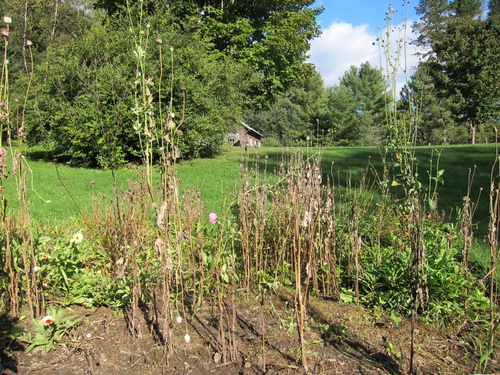

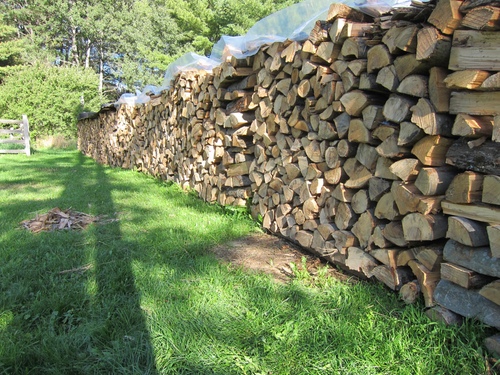
From Soulemama: A Friday ritual. A single photo - no words - capturing a moment from the week. A simple, special, extraordinary moment. A moment I want to pause, savor and remember.
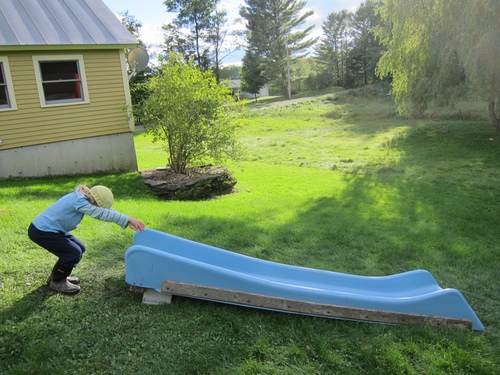
One of my first “play” memories is of an old wooden ladder my mom dug up from who knows where and put in the yard for me to discover when I was about three years old. I spent hours and hours playing on that ladder. Although at times it got propped up on rocks or against trees, I remember it best lying on the ground. The challenge of walking one edge like a balance beam, or navigating the length of the ladder by stepping only on the rungs, or even hopping from grassy patch to grassy patch between the rungs kept me occupied for entire afternoons – or at least I imagine it did based on the few scattered memories I have. It wasn’t much, that rickety, old ladder, but it sure made a deep impression.
Later, the Mungus (short for Humongous, obviously) reigned as the greatest play structure of all time. As my sister remembers, “it was a series of platforms in the trees with chain bridges connecting them and the whole thing was about 60 feet high”. In reality, the Mungus wasn’t much more than a few wooden platforms – some high, some low – with a large tree that came up through the middle. It had a chain bridge (as in, a walkway made only of chains – not a boardwalk with a token bounce for effect), a rope swing (the kind that swings way out and comes back hard – hard enough to knock the wind out of you if you don’t get out of the way after you jump off), and a tire swing (home of the original super-around-the-world spinny, the memory of which makes adult-me feel queasy, but which kid-me couldn’t get enough of). It was the grade school playground and we never tired of it. It physically challenged even the fifth graders. The school eventually tore it down (probably because it was rotting and kids would occasionally break an arm falling - jumping - off) and replaced it with a generic, plastic-y structure that is only 5 feet tall and has stairs and railings all around. Blah.
I miss structures like the Mungus. They don’t exist anymore. And I have to wonder if there really are fewer broken arms now with all the stairs and railings meant to make playgrounds safer. Even if there are fewer broken arms, is it worth depriving children of a structure like the Mungus?
Anyway, this is all leading up to a discovery in the barn. Previous owners of our house left all sorts of random junk around the property, most of which we’d just as soon not have (a 75-year-old rusted manure spreader in the woods?), but every now and again we come across something that we deem a treasure. This time, it was a slide that must have been part of a play structure. We immediately saw its potential, so Dave lowered it down from the barn attic on a rope and we propped it up on a cinder block on the one slight slope in the yard. Very classy.

I know it doesn't look like much, it even looks a bit pathetic considering the Backyard Discovery Playgrounds that are out there. But then again, Dave and I both remember the most magical play from our childhood centering around nothing much– like an old ladder or a rotting platform in the trees.
Sure enough, the girls loved it. Ideas bursting, they played hard (and rough) on the slide for nearly three hours, only stopping because we made them come in for dinner. Katherine is already planning its transformation into a slip-and-slide on the next “hot” day (poor thing doesn’t seem to realize summer is over), and at bedtime, Clara declared she didn’t want to go to school the next day because she wants to stay home and play on the slide. For nothing much, it is a huge hit. I hope it goes down in their childhood memory as the ladder and Mungus went down in mine.


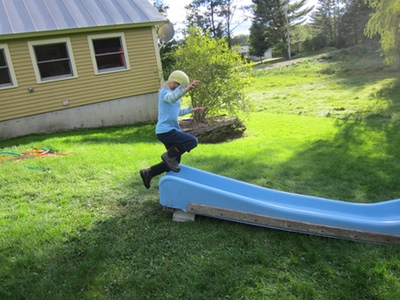
From Soulemama: A Friday ritual. A single photo - no words - capturing a moment from the week. A simple, special, extraordinary moment. A moment I want to pause, savor and remember.
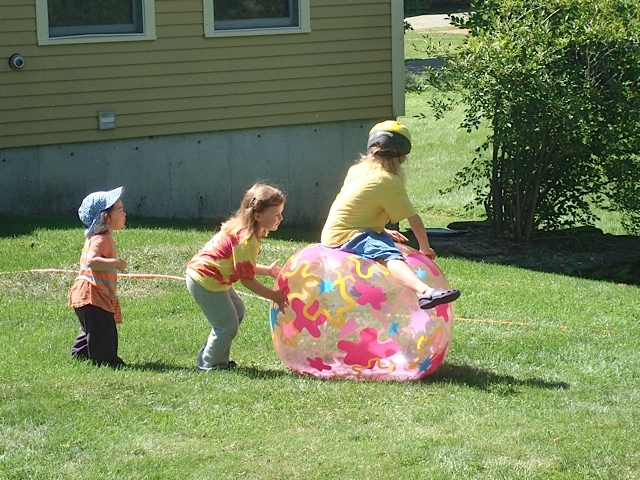
Not too long ago I took my girls to a group picnic at a playground. I spent most of the afternoon following goat girl around as she climbed structures meant for four- and five-year-olds. Katherine and Clara spent most of their time on the swings. Towards the end of the picnic, there were more children than swings, so Katherine and Clara ended up sharing. They created some sort of game by which one pushed the other and then jumped out of the way to avoid being bumped as the swing came back. Shrieks of delight ensued. I mentally checked them off as happily occupied and continued to spot goat girl as she sought higher elevation.
After a while, I became vaguely aware of louder shrieks. I glanced over at the swings and saw that my girls’ game had escalated into a rougher version of their earlier play. Now, Clara was pumping as hard as she could in order to crash into Katherine, who was standing directly in front of her and no longer jumping out of the way. Both girls were willing participants, delighted with their high-impact game. These two have been playing like this all summer, and I’m used to it. But as I turned back to keep my eyes on Alexandra, it registered that several moms were looking at me expectantly. Slowly, it dawned on me that their expression read, “Are you going to do something about that?”
Suddenly feeling self-conscious, I went over to the girls, fully aware that the other moms were still watching me, and told them they were playing too roughly and needed to find a different game. They looked at me with surprise – usually I only step in when I think someone might get hurt, something might get broken, or they are way too loud for the space. But this play was perfectly acceptable to them, and to me. Yet I still stopped them: a classic case of performance parenting.
For the remainder of the picnic, I felt like “that mom”, the one with the wild kids. The one who either doesn’t know how to control her kids’ behavior, or worse yet, doesn’t see the need to. I had the urge to tell the other moms,“Wait! My girls are really good! They’re just having fun, this is how they play together!”
All evening I ran their play, and the other parents’ reaction, through my mind. Were my girls really that wild? Do other kids play rough? I’m pretty sure they do… but as I racked my mind for examples, I realized the question was not do other kids play rough, but do other girls play rough.
I see rough play all the time - on the playground, at school pickup, at birthday parties. But it is usually the boys. Boys wrestling, boys jumping on each other, and boys tumbling on top of each other like playful puppies. Sometimes their rough play bothers me– they knock things down, they crash into others, they look like they might hurt each other. But the words that echo around their play are “boy energy”. Expectant glances from observers (the kind that read, “are you going to do something about that?”) are often met with shrugs of acceptance mingled with modest pride. Boy energy.
There is no question boys and girls are different: in utero, male and female fetuses produce different levels of hormones, which influences development from the onset; studies measuring levels and location of brain activity show differences between men and women; and no one would argue against the fact that men and women are different physically.
But my girls have “boy energy” too, sometimes. As their mom, I should regard their rough play as something they need for their physical development. They are learning control over their bodies and their play should be respected, preserved. Yet, at the first glance from other parents, I felt compelled to shut it down – and I very rarely cave in to performance parenting. It was surprising to realize how deeply I am influenced by this societal norm, especially considering I typically reject traditional gender roles. My girls play with dolls and trucks. Their drawers are not dominated by pink. I mow the lawn and my husband does the laundry. We both cook. But those examples are superficial compared to the behavioral standards that I adhered to at the picnic.
I’m not going to attempt to delve into the complexity of these deep-seated gender norms and their consequences on our society. But I won’t cave in again when my girls play rough. I’ll be prepared with a slight shrug and a knowing smile as I voice the words, “girl energy”.
From Soulemama: A Friday ritual. A single photo - no words - capturing a moment from the week. A simple, special, extraordinary moment. A moment I want to pause, savor and remember.

I'm taking this week off from work... the first vacation I've taken in the last two years that hasn't involved a newborn or a move to a new house, not that I'd call either of those "vacation". I was sure that with a full week, I'd write up a storm, stocking up on a bunch of posts to tide me over until Thanksgiving, or whenever the next break from the usual routine comes. Obviously that hasn't happened. Instead we've been busy with a bunch of little projects. So following Kim's Make and Listen series, here is what we've been up to (well, at least the "making" -- about the only interesting "listening" was Neil Diamond's Forever in Blue Jeans in the fabric store. I love that song.)
Placemats and napkins. Katherine needs to take a placemat and napkin to school with her lunch each day, and having just received my first sewing machine as a birthday gift, I thought this would be the perfect get-to-know-my-new-sewing-machine project. Growing up, I occasionally used my mom's sewing machine in random bursts of creative energy, but was always discouraged by the final outcome - usually due to crooked lines and pieces of carefully measured cloth that didn't match up. Not much has changed. I would call my decision to make the placemats/napkins a random burst of creative energy, and I am definitely discouraged by the crooked lines. Luckily no one seems to care.
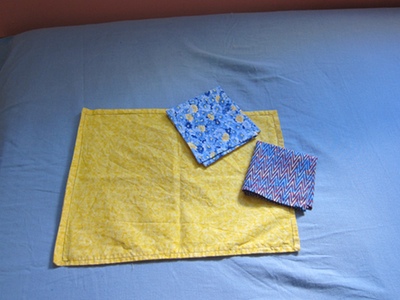
Curtains. Aware that I own a sewing machine, but unaware of my straight line limitations, Katherine's teacher asked me to sew the curtains for the first grade classroom. I warned him about possible crookedness, but he didn't seem concerned. So I agreed... they look great folded, but they measure two inches longer in the middle of each panel and I have no idea why. They also kind of curl up at the corners, another mystery.

Trail. We needed a connector trail from the yard to the main trail. Actually, my sister and I just needed an excuse to get out the clippers and hack away at dead tree branches and drag logs through the woods. We now have a nice connector.

Wood pile. Our wood for the winter (finally) arrived! Good thing I'm taking the week off so we could have a family wood stacking day. We've been looking forward to stacking wood since our early days of dreaming about life in the country. Today we were livin' the dream. I think the novelty would wear off if wood stacking day came more than once a year.


Apple crisp. It didn't last long enough for a picture.
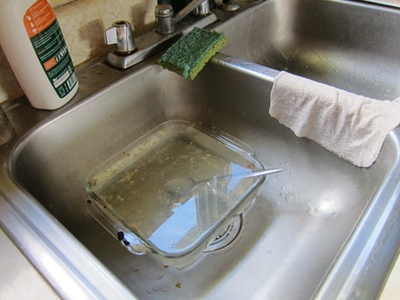
That has been our week. Busy. Now we start the transition into the school year...
From Soulemama: A Friday ritual. A single photo - no words - capturing a moment from the week. A simple, special, extraordinary moment. A moment I want to pause, savor and remember.

While my two city kids took some time to adjust to life in the country, this one here, the youngest, is a country kid through and through. She stalks toads and chickens, squealing with delight if she gets close enough to touch them. She sees a trail into the woods, and she follows it. No matter her sandal fell off and she has one bare foot. No matter no one is accompanying her. A glance over her shoulder and she's off. A steep hill? No problem, she walks up and down the grade with the ease of a mountain goat. Sometimes we just refer to her as goat girl, after all, she learned to walk on the side of a hill. She has surely eaten ten times as many raspberries as the rest of us this summer, disappearing into the thick of the tangled, prickly bushes and emerging with her mouth full of berries and juice trickling down her chin, oblivious to the scratches on her arms and legs. She digs in the mud with a solemn professionalism, serious business that it is, and gathers bits and pieces of flower and earth to mix into her muddy soup. She settles into contentedness as soon as she steps outside.
Maybe she is so comfortable here because this is all she has known, or maybe it is simply who she is, and she is one of the lucky ones who gets to grow up in a place that speaks to her soul.
Whatever it is, our goat girl is home.
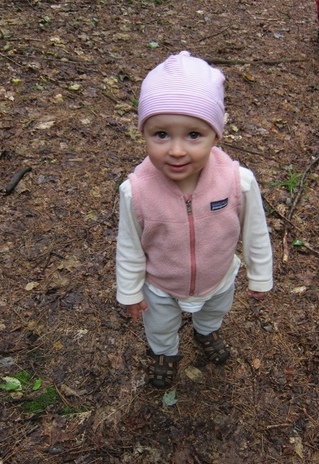
From Soulemama: A Friday ritual. A single photo - no words - capturing a moment from the week. A simple, special, extraordinary moment. A moment I want to pause, savor and remember.

We had dinner with friends the other night - our first friends here in Vermont. We reminisced, as we walked through the woods, about how different the kids were when we first moved here, and how they’ve changed over the past year.
In our neighborhood in D.C., outside time centered around trips to the playground, family outings to nature centers, and walks around the monuments. A special outing on a cold, rainy day was a bus ride to the train station for hot coco – or for a really special outing, a ride on the bus and metro, escalator included. My kids were city kids.
When we arrived in Vermont, I eagerly tried to send them out to play in the yard while I made dinner, or cleaned, or just wanted a moment of quiet. But they wouldn’t go. They’d stand stubbornly by the door and wait for me. If I did manage to shoo them out the door, they’d wander aimlessly around the driveway for a few minutes before returning to the steps to peer through the window to see when I was coming out to join them. These same kids who would race down the city block, let themselves into the playground, and climb for hours without a second glance at me seemed uncomfortable in this new, undefined space around our house. They were fearful of the woods and wary of the steep slope of the driveway and street. There were no fences holding them safely in their play space, no sidewalks or stop signs to mark their boundaries. It must have been overwhelming to a three- and five-year-old.
But slowly they have eased into their new surroundings, regaining the confidence they had in the city. Katherine started biking up and down the hill, and Clara started digging in the mud and collecting rocks. Katherine joined me on long walks in the woods, and Clara followed caterpillars across the driveway. By spring, they were out the door before I could stop them.
Now, in our new home even further out in the country, we walked through the woods with the friends who had welcomed our city kids to their neighborhood one year ago. The kids ran ahead of us, disappearing into the trees, only an occasional streak of yellow shirt or shriek of laughter giving us a sense of where they were. They looped around, meeting us from the other direction, red-faced and out-of-breath, pausing for only a minute before running off into their new freedom again. The woods is now their playground, and they have settled in.
I am reminded once again of the advice I was given years ago: it takes a year, a complete cycle through the seasons, to adjust to a major life change.

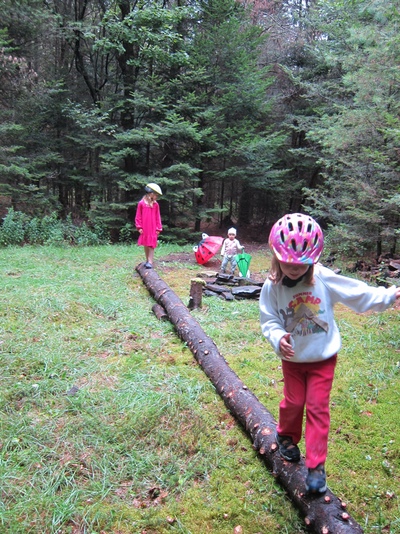

From Soulemama: A Friday ritual. A single photo - no words - capturing a moment from the week. A simple, special, extraordinary moment. A moment I want to pause, savor and remember.

In the other part of my life, the one where I do research in second language acquisition, the work has been very writing intensive this summer, leaving me with little energy for this space. I have a lot of thoughts swirling around that I would love to put down, but when I sit down to write, I find I am all written out. So, I continue on with pictures, recipes and books...
Today, a few pictures. We are all about mud and cake this week.
Tune in tomorrow for what is possibly my all time favorite "This moment" picture!


From Soulemama: A Friday ritual. A single photo - no words - capturing a moment from the week. A simple, special, extraordinary moment. A moment I want to pause, savor and remember.

I discovered this week that giving a blueberry popsicle to a 17-month old is like giving a raw hide to a dog. Total entertainment. It also makes a good pre-breakfast treat for the kid who wakes up two hours earlier than the other kids.
Equal parts vanilla (or plain) yogurt, blueberries, and milk. A touch of honey, maybe a little more if you use plain yogurt. Throw in a few raspberries too. Blend and pour into popsicle mold.

From Soulemama: A Friday ritual. A single photo - no words - capturing a moment from the week. A simple, special, extraordinary moment. A moment I want to pause, savor and remember.

I hear them from in the kitchen, their voices traveling from one side of the house to the other, and I know in a few seconds they will pass through my view from the window. My six-year-old runs with the wind; fast and agile, Katherine flies up the steep grade of our tiered yard and leaps back down the slope over the protruding tree roots without slowing her pace, calling over her shoulder, "Come on! Let's ride bikes!" Clara lags behind, her three-year-old legs sturdy and strong, but not yet fast.
I head outside with the baby and wander around the yard to keep an eye on them while they ride up and down the street. Michael, the 10-year-old across the street, has set up his new jump and is practicing tricks on his bike. My girls watch in fascination. Katherine cautiously takes a turn riding slowly up over the ramp and bumping down on the other side. Clara contents herself to ride around it in circles.
I busy myself picking dandelions and forget-me-nots, feigning oblivion so as not to intrude on their play. I circle up around the back of the house. As I wander back down the other side I hear Michael call out, "Let's race up the hill and back down - whoever gets there first wins!"
For a moment I hesitate, suspended between my instinct to call out "No! No races - Clara is too young, SLOW DOWN!" and my desire to allow her space to figure it out on her own. I look up the steep hill, covered with patches of loose gravel, and the scene unfolds in my imagination: Michael skillfully races down the hill, Katherine close behind, anxious to keep up, maybe even win. Clara, who has not fully mastered her back-pedal brakes, speeds out of control, barely keeping her balance on the tiny, blue two-wheeler. I can see her fear as she looses control, handle bars shaking as she skids across the gravel. She'll fall off, break her arm, need stitches… I won't be able to stop her in time.
But despite the anxiety-driven vision rushing before my eyes, I can't bring myself to call out my warning. From the depths of my own childhood, memories of running free with neighborhood kids silence me. We rode bikes as fast as we could pedal, we did tricks on roller-skates, we forged secret passageways through neighbors' yards, we climbed high in trees where we held tree-house meetings. I broke my arm once, my sister got stitches. But during those long hours after school, and on summer evenings when we played until dark, we were free to figure it out, and it was magical.
I hold onto that cherished time in life, and in a display of casualness, I lean down to help the baby blow the seeds off a dandelion. The white flakes swirl around me as I watch the bike race out of the corner of my eye. Michael and Katherine come speeding down the hill, Clara not far behind, a look of fear on her face as she struggles to control the shaking handlebars. She skids on the gravel, tipping dangerously, unable to brake. Her feet shoot off the pedals and drag on the ground until she wobbles to a stop. She doesn’t fall.
Michael calls out the next race and all three head back up the hill again, as fast as they can pedal. I turn away and look for more dandelions, deciding that perhaps I don't need to watch them so closely.
From Soulemama: A Friday ritual. A single photo - no words - capturing a moment from the week. A simple, special, extraordinary moment. A moment I want to pause, savor and remember.
